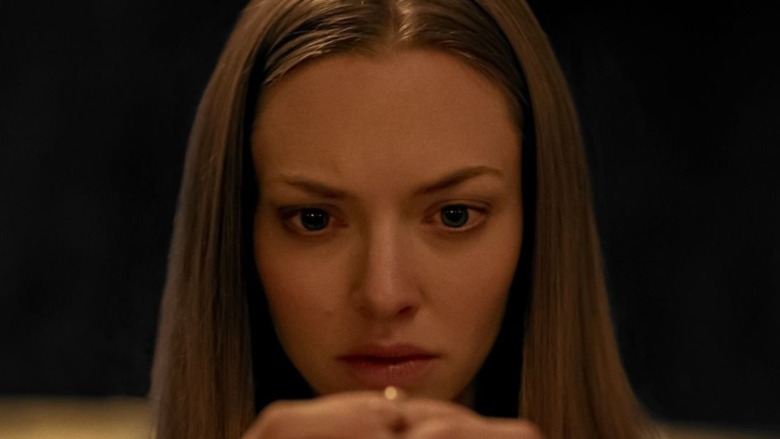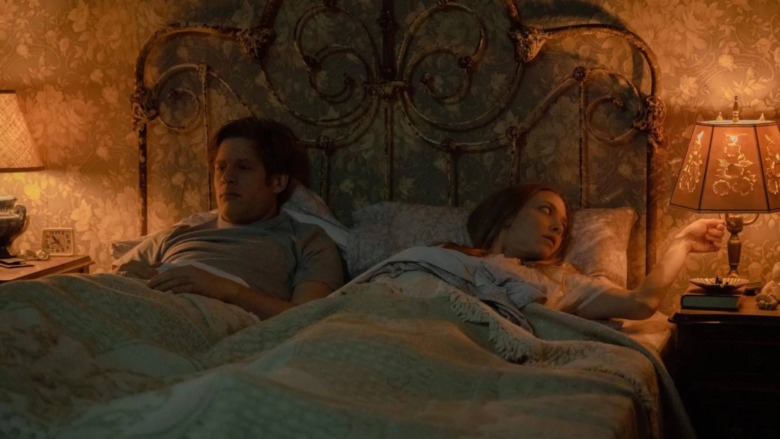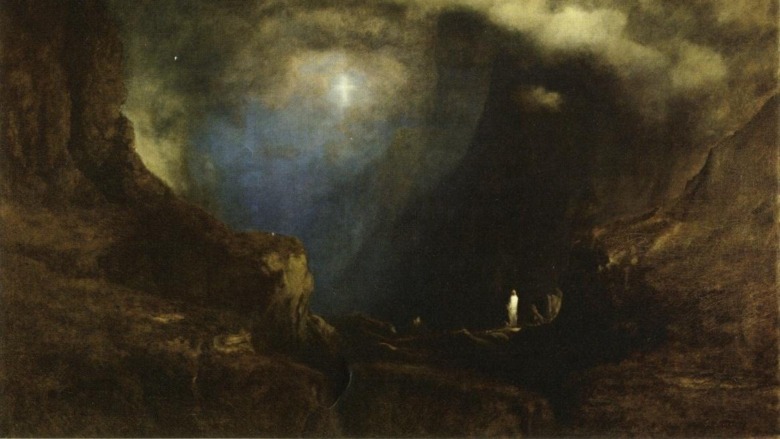The Ending Of Things Heard & Seen Explained
There are many ways films can be horrifying. Some scare you out of your seat with ghosts, demons, and other things that go bump in the night while others use the very depraved side of human nature to burrow into your psyche and make you question if you're capable of doing the same thing as monsters. "Things Heard & Seen," which was released on Netflix on April 29, 2021, merges both of these sources to create a genuinely unsettling experience.
The film follows a young married couple, Catherine (Oscar-nominee Amanda Seyfried) and George Clare (James Norton), who move from the city to the countryside when George accepts an art history teacher position at a small college. She's incredibly unhappy over being isolated from all of her family and friends, and her troubles are only compounded when strange occurrences start happening in their new home. All while that's taking place, dark truths about their marriage begin to come to light.
It's definitely not your average horror flick. It's much quieter and takes its time with pacing to ensure the tense atmosphere can be maintained. As such, you may miss certain details, and in the event the ending to "Things Heard & Seen" left you puzzled, allow us to illuminate the darkness.
A couple come undone
Communing with the supernatural is something of a hobby in Chosen, New York, where the Clares move to. They know that better than anyone as a lot of strange things start happening in their new house like a nightlight flickering on and off. Catherine soon discovers that the house has a history of husbands killing their wives, and just like Chekhov's gun, that's exactly the same fate this married couple ends up in.
Catherine realizes her husband killed one of his colleagues (and attempted to murder another) after they each uncovered one of the many lies he's told. One discovers that he forged a document in order to get the professor job while another uncovers his infidelity. It all comes down to George pulling a "Shining" and bringing an ax down on his wife while she's unconscious. In a way, it's like a prophecy being fulfilled as the violent cycle continues. Vengeful spirits remain in the house who seek to damn the husbands to lives in hellfire. And when we see Catherine again, she almost looks angelic as she's convened with another one of the spirits.
She may have met an untimely end, but it would appear as though she's been saved. George, on the other hand ... not so much.
George's artful ending
You have to get a little philosophical to understand the ending of "Things Heard & Seen." George probably isn't literally sailing into a sea of flames, but rather, it's an allegory for how he's damned himself to Hell for his sins. Try as he might to cover up his misdeeds from forging documents to killing people, he couldn't escape them forever, as evidenced when one of his victims, Justine (Rhea Seehorn), wakes up from a coma. The last we see of her, she's ready to talk to the police.
George believes the only way he can escape is by setting sail, but the camera zooms out to portray a painting that functions as a subversion of "The Valley of the Shadow of Death" from painter George Inness. He was a major proponent of the theological understandings presented by Emanuel Swedenborg, who's namedropped frequently in the movie. The original painting shows an individual walking through darkness, but at the end of the valley is an illuminated cross, symbolizing the eternal salvation of God. However, the final image of the film shows an upside-down cross surrounded by flames, showcasing how George's journey will have him suffering only to wind up in damnation.
The directors on the enigmatic ending of Things Heard & Seen
While it certainly sounds like a philosophically heavy movie, those who worked on it behind the scenes found a way to make it tie into current events. We learn how the original husband who resided in the house thought his wife to be a heretic, so he punished her for such. Society may like to think it's progressed beyond the overly puritan views of the past, but there's still a serious problem today with men attempting to control women. We even see this throughout "Things Heard & Seen" as George frequently attempts to gaslight his wife into thinking she only believes in ghosts due to her under-eating.
Co-director Robert Pulcini spoke on this idea during an interview with Decider: "I think it's actually a very topical notion as we're seeing this kind of cultural revolt going on with, "toxic people" who have gotten away with things for so long getting their comeuppance. There's something very satisfying about this shift of who's damned actually in this story and who has the power to do that. I think there's a spiritual power, you know, feminine power in this movie that really delivers the ending."
Pulcini's co-director, Shari Springer Berman, carried on with this train of thought, explaining, "I see [the final scene] as a metaphor for all the women who have been abused by husbands and fathers and preachers, and teachers and all the business people and producers and all that. Maybe not in this in their lifetime, but in the metaphysical sense of the eternity, of gaining some power."
In light of the #MeToo movement and many powerful men's crimes being exposed, even decades after the fact, it looks as though the scales of justice have gotten a little closer, at least somewhat. There's still a lot of work to be done in terms of gender parity in society, but "Things Heard & Seen" suggests that the tides have begun to turn.



